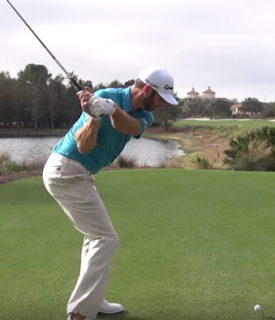|
|
Post by Richie3Jack on Aug 10, 2015 8:42:42 GMT -5
I was trying some things out last week to help with getting enough left leg extension. One of the things I was trying was to keep utilizing Anterior Pelvic Tilt in transition until my left leg had straightened. That actually worked nicely on the range on Thursday. I was hitting it incredibly straight with some more pop. But on Friday it wasn't working so well, so I tried to ditch it. Come Saturday I was playing and I played terribly in bad conditions (windy and wet) and shot 78 (+6). But, I think I can take solace in the fact that playing that poorly before would have likely resulted in a score in the 80's. I also putted terribly as well. I was thinking about what Kelvin teaches and started to come down to some basic principles of the entire thing and I conclude that: If you can sustain the right shoulder external rotation while keeping your left hip behind your left ankle at impact...you're probably about 80% of the way there. The external rotation of the right shoulder is important because it helps prevent you from coming over the top and it does play a small part in not getting stuck. The left hip behind the left ankle is important because it means you are rotating without getting into Right Pelvic Tilt. And when you combine the two, you're going to utilize *some* right lateral bend because you really can't get the club to the ball with right shoulder ER and no Right Pelvic Tilt and sliding unless you use some lateral bend. And the right shoulder external rotation makes it almost impossible to have a high rate of closure. The only big things left I think are the grip, APT to create some room so you don't get stuck and being able to activate the spine engine in order to power the swing instead of just getting enough lateral bend to deliver the club to the ball. I had been watching a lot of this video over the weekend: Nobody rotated the pelvis like Tiger did back then and it was fun to watch. Just watching on TV he looked much faster than the rest of the competition while looking far more effortless. Over the past year I have changed my view on the 'effortless swing.' I think it has more to do with the player's flexibility and range of motion of their parts. But Tiger had as much range of motion as anybody and therefore was able to create a super powerful swing and make it look easy. One of the major things I saw was that Tiger had a ton of APT and used the 'marching move.' But, both of his knees were flexed when he got into APT and then he just started to internally rotate the left hip and extend the left leg. I think this pic shows it pretty well...lots of APT, then interally rotate and extend like crazy. 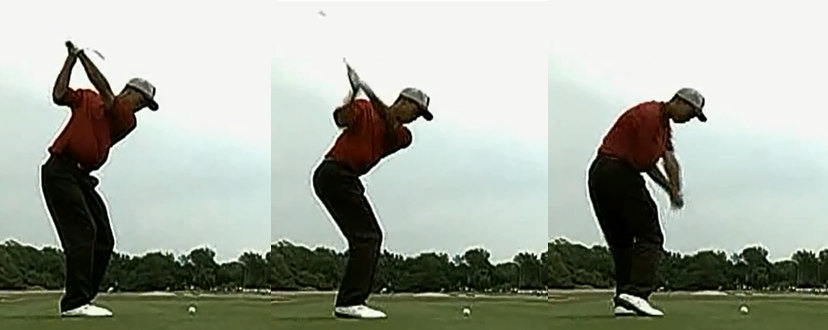 I think what was happening to me over the past 2 weeks (and I still was hitting the ball well) was that I was not getting the left leg adducted enough in the backswing. That was causing me 'kick out the left knee' in transition towards the target instead of using APT in transition to 'pop out' the knee. That left knee 'kick out' move was throwing everything off and then I started to lose my right shoulder external rotation in order to compensate.  Things started to come around a bit on the back nine on Saturday. I hit 1 shot with my 3-wood in particular that I would have loved to see on video as that felt very different, but oh so good. Then on Sunday I shot 70 (-2) at The Majors GC...a course I had never played before in wet and windy conditions and did it with a double bogey on a hole that I doubled because I used the wrong club off the tee. Had I pulled driver out instead of 2-Hybrid, I could have made par and shot 68. I also started putting much better. Once again, I found some of the basics for me with putting were going awry...like swiveling my head in my preshot routine to aim the putter and gauge the distance. Simple things like that can throw everything off before I even make my stroke. |
|
|
|
Post by Richie3Jack on Aug 12, 2015 9:25:58 GMT -5
I would split the benefits of slow motion movement pattern training into 2 main areas: 1. Helping ingrain mechanics without swing thoughts 2. Helping solve the puzzle to certain mechanics you are trying to achieve Yesterday’s range session was about #2. I was pretty sluggish and was sliding the pelvis too much. That’s one of the things that slow motion movement pattern training does for you…you become more aware of what is going on in the swing and are TRULY FEELING the swing. So much so that if something is a little out of place you can sense it immediately. It’s much like if I’m typing and I spell ‘Whistling Straits’ as ‘Whustling Straits’, my brain would immediately sense when I made an error by making the key stroke that inputted the ‘u’ instead of the ‘i.’ That’s what was happening last night. I could start to feel a lack of rotation, the CoP on my left leg at impact instead of more in the middle of my stance. I kept using slow motion training and started to see at first my sacrum was sliding forward. And then I started practicing more and trying to figure out why the sacrum was moving forward…and it was due to that left knee kicking out to the target to start the downswing, again. For me, I’m always helped when I fully start to understand why things are instead of just being told ‘do this.’ I started to see another issue with kicking out the left knee to start the downswing…it makes it virtually impossible to get the left leg action I want going into impact. I want the left leg action to look more like this. 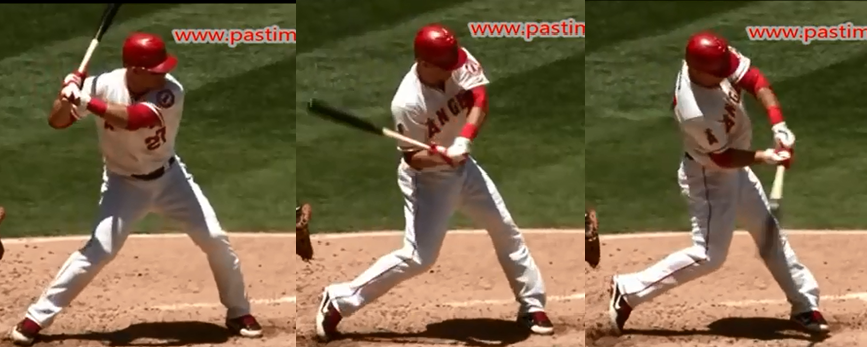 Mike Trout plants the left foot and the left leg extends, the sacrum and left hip move back and away from the pitcher’s mound and at impact the left leg is more or less fully extended. But, if you watch, that left knee does not ‘kick out’ towards the pitcher 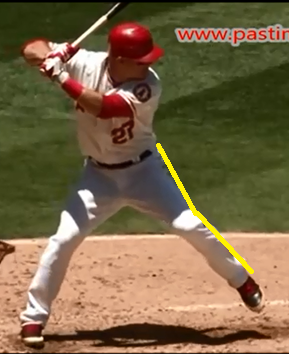 He’s still getting dual external rotation of the hips, he’s just not allowing that left knee to kick out. And that allows him to drive that left leg into extension. The difference with slow motion movement pattern training is that I was able to figure out my issues (without a camera as well) about midway thru the bucket of balls. Without slow motion movement pattern training, I probably would have to hit an extra bucket and be happy if I figured out what was going on in my last dozen balls I get to hit. However, I can’t just stop there. I should be getting better at eliminating this issue with left leg extension and sacrum sliding. For the most part it all starts at transition. Transition is the tough part in making swing changes and is where most people who are changing mechanics revert back to their old ways. The change of direction of the speed makes it hard for the brain to process. So when I go back on the range again I’m going to pay special attention to slowing the transition in the movement pattern training even more to make sure I get things down correctly. |
|
|
|
Post by jnaturally on Aug 12, 2015 21:36:35 GMT -5
Hey Richie,
Thanks for the in-depth reply about the similarities and differences between darome and KM. It confirmed some of my observations and highlighted other movements that I hadn't noticed.
In terms of KM, the lead arm maintains internal rotation and the trail external, what happens to the wrist position? Does the lead wrist move into a slightly bowed or closed position at the top of the swing and in transition?
I've found good distance with the driver and woods using KMs principles, but in comparison the irons seems relatively short. The iron ball flight doesn't seem penetrating(high with a slight cut) and gets worse with more lofted clubs, so I am wondering if I am coming into the ball with poor wrist angles.
Also, is there an ideal Nippon shaft for the KM type of swing, or is it more based on the individual(is there much room for variation within what KM teaches?)
Cheers
|
|
|
|
Post by Richie3Jack on Aug 13, 2015 8:17:37 GMT -5
Hey Richie, Thanks for the in-depth reply about the similarities and differences between darome and KM. It confirmed some of my observations and highlighted other movements that I hadn't noticed. In terms of KM, the lead arm maintains internal rotation and the trail external, what happens to the wrist position? Does the lead wrist move into a slightly bowed or closed position at the top of the swing and in transition? It's preferably to bow the wrist in transition. Mainly in part so one can square the face earlier in the downswing and then just rotate thru and provide great clubhead stability. That's better than having an open face in transition and then trying to time it correctly so it's square at the very last nanosecond at impact. Nobody can tell unless they see your swing. You're probably under-flipping. With the driver you can get some distance with underflipping if you have a poorly fitted driver (too little loft) and start hitting more up on the ball. With the irons the underflip will cost you distance because you really can't hit up on the irons. Shaft fitting is always about the individual and their own swing and not the philosophy of teaching. Victor Rodriguez has to use wayyyy stiffer shafts than I use. His release point is much later than mine and he's generating far more force than me. So he needs an extremely tip stiff golf shaft. I tend to prefer very tip stiff, but more butt soft golf shafts. Since working with KM my start down move in the downswing is different...it is more 'aggressive' and less 'floaty' so I can now play with a stiffer butt section shaft. Before KM, I had a UST Mamiya ProForve VTS Red 7x shaft in my driver. The head broke and I had a backup that I couldn't hit very well that had an Aldila RIP Beta shaft in it. Before KM, I couldn't hit that Aldila RIP Beta shaft very well. When I looked on the bend profile software, they were similar profiles, but the Aldila shaft was much more butt stiff. So as I changed to KM's swing, I was able to hit the Aldila shaft because my startdown changed and I was actually hitting it better than the UST ProForce VTS shaft. I tend to prefer the very tip stiff shafts (not as stiff as Victor's golf shafts) because I generally tend to put too much spin on the ball. I will say that if you can stabilize the club head as well as Victor can using the drive-hold release, you can still hit a ball dead straight, time after time, despite using a shaft that is too soft. I saw Victor in person hit other people's clubs that had way too soft of a shaft and he never wavered off line. They would just go too high and spin too much. Sadlowski has a trick driver with an incredibly whippy shaft and he hits it very precisely. 3JACK |
|
|
|
Post by Richie3Jack on Aug 13, 2015 9:36:44 GMT -5
Last night only solidified my love for slow motion training even more. I started to slip into sliding and kicking out the left knee toward the target on Tuesday and I noticed that they were really all problems occurring in or immediately after transition. So, I made a point to really slow down the transition portion. If I was going at 10% speed for my swing, then I would try to go at 5% speed in transition. What I found was that my speed in transition was actually a bit quicker than my full speed swing. So if I was trying to go 10% speed, I would go 25% in transition. By paying close attention to the speed in transition and slowing that down, I was able to figure out some things. For starters, I think it's a 2 part deal where I was not starting transition with Anterior Pelvic Tilt and instead starting it more with the hands. That would cause the slide, but also cause me to lose the external rotation of the right shoulder in the downswing. So, it was partly about starting the transition with APT and also getting a better right elbow move. This is one of the parts where I disagree with the 'start from the ground up' camp the most. Is Tiger really flexing his knees in transition or is he getting into APT which lowers the pelvis and helps create more knee flex? 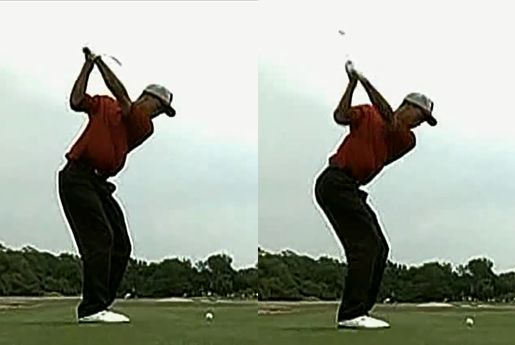 To me, I think it's undeniable that Tiger is getting into APT and that is causing more knee flex rather than just getting into knee flex. Without the APT, you're not going to be able to rotate the pelvis and with just knee flex, you're creating vertical (jumping) forces and far less rotational forces. So it's no small wonder why getting APT is so important. And I have found that if I don't get it soon enough in the transition...I'm cooked and I don't have a chance of getting it again in the swing. The other thing I started to realize with the slow motion training is that my brain still has a thought process of being afraid of hitting a slice with the right shoulder external rotation. It's something I have to fight because the reality is when I do the right shoulder external rotation and sustain it, I'm more likely to NOT slice it. And I think that is something that slow motion training will help me get that thought out of my mind eventually. It's funny, because I was watching these videos of the 1953 Ryder Cup: All of the best known players like Burke, Middlecoff, Snead, etc. all had the similar trait of really getting very rotation with the pelvis and you would think that it would create big cuts, but they were able to hit draws all day if they wanted to. All of the lesser known players had swings that were more linear. And you think about some other 'olde tyme' players like Hogan and Nicklaus...very rotational. Sure, the equipment is different. I think a golfer would be hard pressed to hit more than +2 degrees with persimmon woods with any type of consistency. But, I think they were able to take out the left side of the course and you could see smaller guys that were not going to the guy that were able to swing very heavy clubs very fast and with great control. The speed came from the body rotation (with some vertical forces) and the control came from the ability to sustain the right shoulder external rotation. |
|
|
|
Post by Richie3Jack on Aug 17, 2015 8:58:11 GMT -5
This past weekend was the worst I've hit the ball in months which was a bit of a surprise give how well I was hitting the ball on the range leading up to that point.
Saturday we played Eagle Creek which is an easy course that I should be able to shoot under par if not in the 60's. I started out okay, but then we caught up to a tournament that had a shotgun start. And then there was lightning in the area and a twosome who was slower than shit jumped out in front of us. It was a lot of stop-n-go and hurry and slow down and I was doing something I haven't done in months...miss left.
I was +3 with 3 holes left before the lightning got a bit too close for our tastes and we headed in.
Then I went to play Celebration at 8 AM on Sunday and it was cart path only and it was slow and hot. 90 degree heat with 70% humidity isn't fun. And my game was abominable. I started to figure it out on by the 14th hole a bit although I didn't hit a good drive on 17. Finally, I hit a drive like I normally can do on 18 with a drive that I bombed right down the middle.
In the end there is good news to this in that if I can shoot 76 (+4) at Celebration, putt awful and hit it about as bad as I can, I can take solace in the fact that if I hit it pretty well and putt pretty well I can go low there and I don't think Celebration is an easy course by any means.
Obviously, the clubface was closed at impact. I was missing left and hitting them low. The good news is that for the most part my face contact was really good. My belief is that I started to, as Monte Scheinblum described in this video, moving the head and torso laterally towards the target.
Again, I don't quite agree with everything said in the video, particularly the lack of discussion on the actual release style and what the rate of closure is doing.
But, sliding the torso and head forward to create more forward shaft lean is an old habit of mine. The pelvis can stall and I did start to feel a little bit of the biggest death move in my swing...Right Pelvic Tilt (which comes with sliding). Because the pelvis stalls the hands are now prone to roll over and I was not quite keeping that right shoulder in external rotation.
So, I hit plenty of miserable shots.
But, I was also able to hit enough good/great shots that I made 4 birdies at Celebration despite my putting being an absolute train wreck at the moment. That's one of the things I plan on discussing in 2015 Pro Golf Synopsis is gain bias vs. loss aversion and how and why I think that is so critical to a golfer's success.
Anyway, I will be getting back to plenty of movement pattern training this week provide the weather holds up (I think August is the worst month for weather in Florida).
The other thing is that I'm going to attempt to do this movement pattern training for my putting stroke as well.
I took a lesson from John Graham in January and it helped me tremendously. It was an AMAZING lesson. I then started to use an ArmLock putter and that worked nicely.
Part of the problem is that I do not put much practice time into putting. That will change.
But, I still find myself with the same issues as always. I'm having too many putting stroke thoughts and I'm too worried about aiming and I still can't aim a putter for shit. I'm not looking for dead square, albeit that would be nice. But if I can get within 2 degrees I would be satisfied.
I've tried everything and nothing lasts with any permanence.
I was reading a Tweet from John Graham and he was saying that in his experience most people with aiming issues should actually work more on their putting stroke and if they correct some major flaws in their stroke, they'll learn how to aim.
This makes sense to me. If I'm aimed 5 degrees to the right, I will compensate for that by changing the face angle and the path to move the ball left of where I'm aimed.
But, if I can continue to keep a 'good stroke', which is a big if, eventually I will start to figure out where to aim to get the ball to the hole.
At least that is the logic.
As I like to say 'your best thinking got you here.' For me, my best thinking on how to aim has produced unsatisfactory results. So maybe a new line of thinking will work. And like I started to learn from the Scheinblum video...I think more in more in golf if you want to do something, you probably have to do the EXACT OPPOSITE of what logic dictates. Trying to not flip? Feel like you are throwing it away as fast as you can. Trying to rotate the pelvis counterclockwise? Rotating the left hip clockwise. Trying to aim better? Probably need to fix your stroke.
The issue here is that the putting stroke is so short and quick and relies on gravity to let the putter head fall. And one thing that kills 'using gravity' is to move the putter at a slow speed.
My plan is to focus on the backstroke and the transition. If I can get those pretty good, I think the rest will work.
For instance, I tend to take the putter head outside in the backstroke and close the face because I have a right aim bias. So that will be cleaned up.
Secondly, I started to notice that when I used movement pattern training on the putter and got the backstroke correct, I would then loop it over the top. Again, a compensation.
Eventually, I can't help but have the putter head go into impact. So my goal is to work on hitting up on the putter with a short follow thru because that's how it is done when you correctly allow gravity to do the work.
|
|
|
|
Post by Richie3Jack on Aug 17, 2015 9:19:04 GMT -5
I forgot one thing. I decided that if I was going to do movement pattern training to develop my stroke, I wanted to use an Anser style putter. I was looking for something 'neutral' in aim bias qualities which means: Anser style model, plumbers neck hosel (standard length and offset), alignment line on the back flange. I didn't want any design with a bias. I wanted a 35" putter (I think we've gone way too far in making 32" to 34" putters). I wanted a putter head 350-360 grams. And I wanted a putter that felt really good when I strike it. I started to think of when I really putted best in life and that was with the following putters: Wilson 8802 Ping B61 Tad Moore Custom shaped more like a B60 model Mizuno Scotty Cameron Most of my woeful times with putting have come with the more mallet style designs or the Zing style design. So I just wanted to go to a neutral style putter and work on it from there. I ended up getting a TaylorMade Ghost Daytona Putter  I tried out a bunch of different putters at the PGA Tour Superstore. I was looking at the Kenny Giannini putters, but they just didn't feel that great. The Ping Anser 2 putters were too light. The Scotty Cameron's are too flat. The Odysseys are too short (the ones they had available). The Cleveland Classics were too head light. It came down to the Bettinardi BB1 and the TaylorMade Ghost Daytona and I really couldn't tell the difference, so price won out as the TM Ghost Daytona is about $170 cheaper. 3JACK |
|
|
|
Post by Richie3Jack on Aug 18, 2015 9:58:25 GMT -5
Monday was an up-and-down battle, but I started to figure out things quite well. What is different with slow motion practice is that I can now figure out things earlier. With my old practice habits I would usually figure out things on my last handful of range balls and then the range would be closing down. I started to see that I still had the old nemesis of ' kicking the left knee out towards the target' disrupting things. I felt like I was not doing that over the weekend, but I was sliding the sacrum forward in transition instead of getting the APT to do the work in transition. From there, I wasn't able to get into dual hip IR after having dual hip ER. I just went into dual hip ER with a slide of the sacrum and stalled the pelvis because I had no way to keep 'firing' the pelvis moving. I eventually came up with a swing thought sequence that I used in my *practice swings.* 1. Wind the leg in (get the left knee behind the ball in the backswing with left hip IR at the top of the swing) 2. Sit it Down (sustain the left leg assembly formed at the top of the swing and just go into APT and that will 'sit down' the left leg (with the left foot re-planting) in the proper position 3. Kick the Bucket Over (The visual of the bucket drill where you rotate enough to kick the range bucket over). So again, A) Wind it in B) Sit it down and C) Kick the Bucket over. Again, I only think that in the PRACTICE SWINGS which are in slow motion. The goal is then sort of memorize the motion and NOT the swing thoughts when I'm taking a full swing at 100% speed. I find when things are going good, I really don't have any swing thoughts...even in the practice swings in slow motion. That's why it's kind of a bummer when I struggle and I may 'get it', but have to use swing thoughts to figure it out. Even if I'm using them in the practice swings, my best performance comes when I don't even need them in the practice swings. *** I also started to work more on my putting. It's the same type of practice although I have to get the hang of it because the motion is so short and requires so little effort to begin with that moving at a slower speed is very cumbersome. One of the things I started to figure out was that if I grip the putter like normal, the face is more or less square. It looks left to me because I have a right aim bias. So instead of aiming the putter face, I decided to just grip the putter like normal and try to 'aim the path.' I just step up to the ball and I focus on the putter path and trying to create a path that the will be square to the target. Before I would carefully aim the putter face and then just make a stroke. Now I'm aiming the stroke and wherever the face is pointing doesn't matter. *** I also had some breakthroughs on trying to hit the low spinning pitch shot. The goal is always to try and catch it clean. Catch it on the 2nd groove and don't take much turf and the ball will roll up all the grooves and spin because the friction is greater. Sometimes I can get it, but other times I take too much turf. What I started to do was play the ball up a bit more in my stance. I found that if I keep the hands forward and rotate the pelvis fast enough, that will provide me with enough forward shaft lean. Combine that with hitting it low on the face, I can still get that low trajectory despite having the ball more forward in my stance. I also found that you really have to rotate so much that I feel almost like I'm behind the ball at impact. It's a shot that doesn't work well with any bit of slide. And once again, it's almost that direct opposite of a procedure that counters what common logic would dictate. In order to hit it low, you have to do things that are more in line with hitting it high (up in the stance, feel like you're behind the ball). |
|
|
|
Post by Richie3Jack on Aug 19, 2015 9:33:53 GMT -5
Not much new other than I had a very good ballstriking session yesterday. I started to work more on using slow motion into impact and that helped. The swing started to feel like it should. There was none of that immediate feeling that I was just a little bit off. I relate that to mis-typing a word. I might not even know what letter I mis-typed, but I can immediately sense that the motion I made with my fingers was off.
I did find that I had some sliding issues, particular with my head.
I also worked on the putting some more and it's really coming along. I'll be curious as to the timeframe to when my putting stroke becomes better and automatic. On one hand I think it could take a long time since I've putted like this for a long time. On the other hand, I think it may take more quickly because the stroke is so short. I am curious to see how the actual stroke looks like in the SAM Puttlab. It appears to be easier to let gravity do the work when the stroke is arced more properly. I think if I cut across the ball or loop it over, that is my hands manipulating the putter and I can't get the gravity to kick in. With a properly arced stroke, I think there is less hand manipulation.
This week I'm set to play Summerglen which is a very short, but tight course with slow, undulated greens. Then I play Falcon's Fire which is much longer, but may be more getable because the greens are smoother.
|
|
|
|
Post by Richie3Jack on Aug 20, 2015 8:32:24 GMT -5
Started to get it much better yesterday. But, it was another lesson involved. Particularly one of why you should practice with your driver. I was pretty much striping the Yonex 3-iron. The driver was a bit more shaky. It's a different club with vastly different properties, so the brain starts to react to that. But, by the end of using my driver I was hitting it quite well despite my hands being sweaty (88 degrees with 75% humidity will do that).
One thing I started to think about in my practice swings was trying to get the left knee kicked in behind the ball in the backswing (which I already do) and the trying to keep that left knee behind the ball for as long as I can. Eventually between the Anterior Pelvic Tilt and the pelvic rotation, the knee will no long be behind the ball.
I still have a problem with sliding my head forward in the downswing. I think that causes me to slide the body. I started to get it really well with the 3-iron, but when I started with the driver I was once again hitting some closed face, low pull draws. I figured that the pelvis was stalling a bit and then started to feel that pelvis stall. I think it was a combination of the head moving forward, the pelvis stalling and then getting out of right shoulder external rotation (into a little bit of right shoulder internal rotation).
So, I started to focus on that head movement and 'kicking the bucket over' but not sliding the body forward while doing so. And I changed my grip a little as the left elbow wasn't pointing at the target at address and I could then feel that in the downswing.
It seems like a lot, but by the end of the practice session I didn't even think about it with slow motion practice.
|
|
|
|
Post by Richie3Jack on Aug 21, 2015 8:24:08 GMT -5
I think I finally 'got it' last night with the swing on the range. I was struggling pretty badly on the range early on and things just didn't feel right. And I remembered how I used to 'rip thru the ball' which is in my terms about opening up quite violently and sending the ball the straight at the target, just like the ole timers used to do.
I wasn't doing that and eventually I just started focusing on just that. What it takes is for me to 'kick the bucket over' with my left calf by properly rotating the left hip and the pelvis. But it also requires me to do what I call ' delay the hit.' When I say ' delay the hit' it's about sustaining the right shoulder external rotation. I think Dustin Johnson is a great example of what I visualize as ' delaying the hit' The video doesn't really do it justice. I saw a video from out in front at about a 45 degree angle that creates a better visual. But, it just looks like (not actually scientifically happening) that DJ gets that right elbow out in front of his hip in the downswing, but the club head doesn't arrive to the ball until the pelvis starts to clear and 'propel' the hands to move forward. This is versus the players that do not really rotate the pelvis and throw their hands at the ball with right shoulder internal rotation. Once I started to visualize that, everything started to click and the feel was back to its old self. It would be like trying to type the word 'Wyndham' and constantly typing it as 'Wunhdam' and knowing that the motion of the fingers typing 'Wunhdam' feels incorrect. Now I'm spelling it 'Wyndham' correctly and it's a eureka type of moment. I also got my first practice on an actual putting green with the new putter and the movement pattern development training. And I actually putted very well which was beyond surprising because the green had been punched and is still in recovery mode and was extremely bumpy and slow. One of the things I worked on the actual putting green was to take a practice backstroke as I addressed the ball. From there, I wanted to just replicate the feel of the backstroke. I had some times when I accelerated the putter thru instead of letting the gravity do the work, but that's all part of the learning and skill acquisition process. |
|
|
|
Post by Richie3Jack on Aug 24, 2015 8:29:54 GMT -5
This weekend my swing was much better than it was last weekend. Actually, the face contact was superb. I don't recall ever missing a shot well off the toe except for on 1 hole when I was trying to purposely hit a draw and I caught it a bit off the toe and it still produced the shot I wanted. I did have some issues with hitting some cuts. On Saturday it was a bigger issue early on, but I then started to get it. On Sunday I hit a few stray over-cuts. I'm pretty sure the issue is more about sliding the sacrum forward. The putting was awful. Although both courses (Summerglen and Providence) had tough pin locations and slow greens. I started to adjust things a bit by really not focusing on the putter head and instead focusing on the ball and where I wanted the ball to travel and what stroke was needed to propel the ball in that direction. I also started to figure something else out....my best putters that I had ever putted with had the hosel as far off to the heel as you can get. Here's a look at the Ping B61 which I used to putt great with as a junior golfer: tQ~~60_35.JPG) I used to have a custom Tad Moore that I bought off a friend. It was a one off and had the same hosel direction and I used to putt really well with that, too. And of course, the Wilson 8802.  I don't think the 8802 style is very feasible in Florida because at 2* loft, the greens are too slow. I think I need more of 3 to 3.5 degrees of loft, so an Anser style model is probably better. Anyway, it was hard to putt on those greens learning the new movement pattern because they were put in difficult location and with the slow speed of the greens, that would mean larger backstrokes which I haven't really practiced for. But, I still see progress there and I will continue to work on the movement pattern training with the putter. 3JACK |
|
|
|
Post by Richie3Jack on Aug 26, 2015 9:38:50 GMT -5
Recently I have been getting some putting practice in almost every day that I go to the range. However, I just do the putting practice on my putting green at home. I'll spend about 45 minutes to 1-hour on the range and then head home, get some dinner and put in about 30-minutes of putting practice. I'm still not quite there with the swing. The past couple of days I have lacked some second firing and you have to have that or all of the work you've done up to that point is for not. Essentially, there is still a little pelvic slide in there and not enough second fire and then a loss of right shoulder ER. I'm not hitting it poorly, but I'm hitting too many bad shots and the leftward misses have crept in. All I can really do for now is to get more movement pattern training in and slowly eradicate that crap from the swing. I'm playing golf the next 4 days. Thursday is at the Legacy Club at Alaqua Lakes thanks to my friend Brendan Kennedy. Brendan is the instructor at Legacy Club and has a vast amount of excellent students like Florida State Am winner Thad Hudgens and Mimi Chen who won at Pinehurst in her age division by something like 11 strokes. Brendan is a stick, too. He played at UNC and can still pipe it. He will be getting the Noitom MySwing 3D MoCap system, soon which should only add to his swing and playing expertise. Legacy Club is one of my favorites. It's a Fazio design that gives me problems. I shot 68 there the second time I played there and haven't played well there since. I shot 76 there in the Mid-Am qualifier, shooting 43 on the back nine (which was my front nine) and then 33 on the front with a 3-putt. I haven't played there in a couple of years. Not because I don't like the course, but it's not a good fit for me and I usually get on the course in tournaments and it has been a struggle each time. So, it will be interesting to see how my new game plays Legacy Club. Friday we play Mission Inn El Campeon. It was a George C. Thomas design all the way back in 1917 and is unlike most Florida courses in that it is quite hilly. I've played pretty much very well there or awful there. Saturday we are playing SkyView at Terra Vista. I had never heard of it and decided to give it a look on GolfNow where it had several very positive reviews. I then saw that the designer, Terry Lagree, also helped design Harmony Golf Preserve and Black Diamond Ranch and I was sold. I haven't decided what I'll do on Sunday. I may take a look at PGA Village down in Port St. Lucie. Depends on what the weather is doing and if we don't get killed by hot weather on Thursday thru Saturday. To me, August weather is the worst weather in the state of Florida. Technically it gets hotter in July. But, in August the humidity gets noticeably higher and that humidity lasts ALL DAY LONG. Just like Sunday when we played Providence Club and it was 'only' 85 degrees, but the humidity was at 82%...and it was only 10:30 in the morning. That plays a role in trying to get practice in because it's hard to get in a large basket of range balls in if my hands are too sweaty beforehand. Anyway, I have been making some progress with my putting. I've been using the Pelz Putting Tutor recently:  I'm not a big fan of most drills or training aids. I think because the putting stroke is so short that changes the training a bit. But, I still try to avoid drills and training aids. What I do like about this is that it doesn't really restrict or forcefully change the player's stroke. If you knock over one of the marbles, the golfer can then figure out why that is happening. For me, I think I'm starting to get the aiming down better. It still looks like I'm aiming left if I focus on the putter blade, but if I focus on the alignment of my hands it *feels* square. The other part I noticed is that I still have some small cut-across in my stroke and found that I almost visualize like I'm trying to hit a small draw with the putter. And the stroke feels much better when I get it right. Feels like it is much easier to allow gravity to do the work. So, I plan on continuing to work on that and once I get that down, I'll check out and see what the SAM Puttlab says. |
|
|
|
Post by Richie3Jack on Aug 31, 2015 19:50:43 GMT -5
It was my birthday on Thursday, so I decided to take Thursday and Friday off from work and play golf with my dad. My swing was having some residual issues leading up to Thursday that I was hoping to work out before Monday as Hurricane/Tropical Storm/Flood Watch in Effect/Late Night Showers/Scattered Afternoon Showers/40% Chance of a Shower Erika was forecasted to come in. It would also be some time on real putting greens in real putting situations and I wanted to see how it would work out. I shot 74 at Legacy Club Shot 74 at Mission Inn El Campeon And I shot 74 at Skyview at Terra Vista I didn't hit it all that well at Legacy Club, but I hit enough great shots to keep the score respectable. That night I started to work on some things in front of a mirror and started to feel that my trunk balance was way out of whack. Kelvin's article on trunk balance really explains it: kelvinmiyahira.com/articles/19-2012-articles/76-2012-06-trunk-balance-more-on-how-to-turn-your-hipsIt's funny because it's a similar move to what is taught in M.O.R.A.D. with extending the spine in the backswing. I think where the S&T people get it screwed up a bit is that they are tilting so much towards the target that they create left pelvic tilt and that counters the spine extension. For me, improper trunk balance is due to just getting the pressure of my feet more towards the toes. I have always been like that. I often notice that when I stand, the pressure is usually towards the toes instead of more towards the arches of my feet. So I started working on that and it was more about moving the pressure in my right foot to the heel instead of the ball of the right foot. I took that to Mission Inn and without any range practice, I started to catch on quickly with the driver. In fact, I only hit 3 weak drives which occurred on #14 (decently struck flare), #17 (struck low on face cut on a ridiculous hole) and #18 (bail-out cut). That late fizzle is bound to happen when you're learning something new and with proper movement pattern training, you can quickly get rid of those late round fizzles. It took me a few more holes to get used to the trunk balance move with the irons, but I started striking them well, too. On Friday night, I did some more movement pattern training in front of a mirror and started to refresh the memory of this video: The big thing about this video is the CoP distribution throughout the swing and the CoP trace. Victor's pivot action creates a CoP trace that 'fishhooks' instead of arcs almost in a straight line. I was reading something online where Jason Day has a fishhook trace as well which is different from the 'kinetic chain' people that want an arced CoP trace. The reason why this happens is based in the CoP pressure throughout the swing. Victor starts with 67% of the pressure on his left foot and 33% on his right foot at P1. 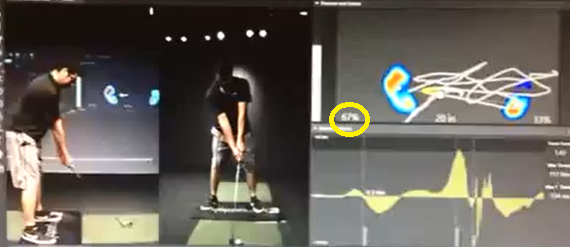 At about p4, Victor gets to 100% of the CoP on his right foot. I also notice how he has trunk balance and the CoP is on the heel of the right foot. 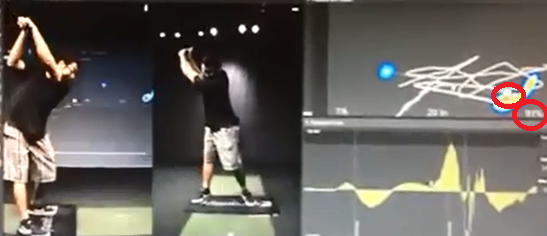 But, where it gets interesting is in the transition where he goes from about 97% of the CoP on his right foot to about 11% because his left foot has 89% of the pressure on it. 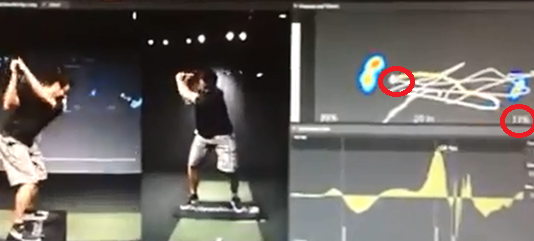 However, where it gets *extremely* *interesting* is the right foot has gone from 97% at P4 to 11% in transition...then it gets to about 48% at impact. That means the left foot goes from 3% at p4, to 89% in transition to 52% at impact. 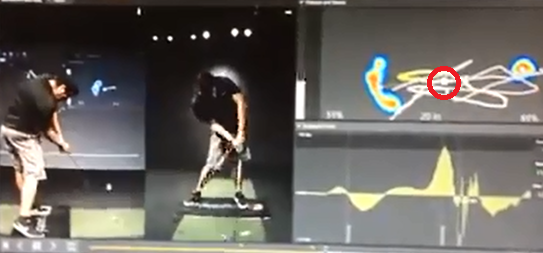 I think what part of the issue was I wasn't getting the 'hook' of the CoP trace. That's probably why I didn't quite feel the second fire happening because you can't get the hook without the second fire and vice versa. But, by the same token I still need to feel like I'm moving the sacrum straight back as I go into Anterior Pelvic Tilt in transition. I don't believe it is worthwhile for me to get any conscious slide of the pelvis. I think the CoP transferring from the right foot to the left foot should naturally happen as the pelvis rotates from being closed at P4 to almost square at p5. But, the transfer of CoP from the right foot to the left foot should not be induced by sliding. I just had to remember that once the pelvis rotates to square, that CoP has to start 'backing up' and you do that thru the extension of the left leg with the hips starting to internally rotate. I didn't start to remember this until I started doing slow motion practice in front of the mirror and worked on using the correct mechanics which include keeping the left hip behind the left ankle at impact. You can't do that with the arced CoP trace. So at SkyView I was fully back ripping drives and irons. I had a couple of bad shots on the back nine due to being tired (long week and out-of-shape). I also had a poor drive on the 15th hole due to bad psychology. I had been developing a 2-way miss again over the past couple of weeks and didn't quite trust my ballstriking even though it was fully back to form and got on a narrow fairway and bailed out instead of just focusing a little left of the target, hitting the shot I wanted to hit and knowing that I would only miss to the right if I missed because I don't miss left when I'm playing like this. As far as my putting goes, it was rough out there for me but I did see progress. The issue I had was hitting the ball too hard because I feel my putting stroke has improved and now I'm hitting the putts further with the same amount of effort when stroking the putt. I'm still focused on the setup of my hands, my backstroke (keeping it arced instead of outside to in) and not cutting across on the thru-stroke for now. Eventually, I will start working on 'letting gravity do the work' and aiming more. I plan on writing a blog post about it soon. And overall, the reason why I didn't shoot lower scores was due to the putting being the main culprit. |
|
|
|
Post by Richie3Jack on Sept 3, 2015 9:59:32 GMT -5
I took Sunday and Monday due to the rain. Tuesday I was in a hurry because I wanted to go to the PGA Tour Superstore to get new grips put on my putters, so I only got about a half of a bucket in.
Wednesday I was hitting the ball well again and making it look easy. I have to say that the Monte Scheinblum video with Brandon DeVore helped me understand Kelvin's teachings even more:
Especially with this video of Victor Rodriguez on Swing Catalyst force plates:
As Kelvin has discussed endlessly, sliding is generally not good. There are some golfers that get away with it. Or golfers like Hogan who would drive-hold release despite a big slide early on in the downswing.
But, I think the tendency is for many golfers like myself to start sliding the head and the torso and that causes the rest of the body to slide as well. Once that head/torso slide is gone, now the golfer can work on getting the pelvis to not slide and rotate (along with avoiding right pelvic tilt).
There's going to some shift as we rotate the pelvis and torso in transition, but it should be more of a pressure shift than a big shift of the actual body parts. Then from there if you rotate the pelvis enough, the CoP will fish hook and come back towards the center (50/50) at impact. I think highly of both videos put together because the Scheinblum video shows a common flaw from about p4 to p5.5 (sliding the head and torso forward) and Victor's video shows how the lower body needs to work, especially once you get past p5.5
I'm pretty confident that I get this down and in a couple of weeks (weather permitting), I'll get a video into Kelvin and see what tweaks we can make.
I've been working more and more on putting and it's starting to get better and better.
Having discussed putting with the following proven, Tour putting instructors:
Geoff Mangum
Phil Kenyon
Jeff Smith
John Graham
David Orr
The one commonality I have seen is that they believe that what separates Tour players from amateurs on the putting greens is the launch direction. The Tour player can hit their putts more accurately to where they are aimed and do it more consistently than the amateur.
So you have 5 different putting instructors from different backgrounds and learned from various people and they have one very common belief.
Geoff discusses it here with the BOOM thought process.
Before I started watching a bunch of these Mangum videos, I noticed using the Pelz Putting Tutor that I almost had to feel like I was trying to hit a push-draw with the putter in order to get the ball to launch thru the marble gate.
Geoff has discussed that the natural tendency for most golfers is to yank the putter head inward at and thru impact and how they need to keep the putter head going down the line for about 2-inches after impact.
Eventually I found that I have 2 issues with my putting stroke:
1. I do yank the putter head inside right at impact as Geoff discussed.
2. I have a tendency to close the face shut at impact.
When on the Pelz Putting Tutor, when I hit the gate, I hit the left marble about 95% of the time. I rarely hit the right marble.
Eventually I worked on not yanking the putter head inside, but still had some issues with hitting the left marble and found that I was closing the face. This would probably lend credence to why in part I have a right aim bias....I yank the putter and close the face too much and the ball tends to take off left at initial launch, so I countered that with aiming right. With that said, I still think there are some basic tendencies to aim right due to my dominant eye (left eye). But, I'm not looking to achieve perfect aim with the putter. If I'm off by 1.5 degrees, that is fairly acceptable.
Another good video I found from Mangum was this one:
What I like about Mangum's work is that it is neuroscience centric instead of physics and geometry centric. He's not easy to understand, but when you do understand what he is saying you start to see the brilliance in his work. That's why he and Elk make such a great combination because Elk knows how competitive golfers think and can translate it to us so that it not only makes sense, but is believable.
I really like the visual that Geoff talks about with placing a CD in the grip and pretending it is a circular saw that is slicing right thru wood in the follow thru. I started to use that visual and actually practice with CD's on my putter grip (it would be nice to have a clamp apparatus to hold the CD in there) and my performance on the Pelz Putting Tutor has improved. I'm still doing movement pattern training and it helps with the CD attached to the grip drill.
The ball tends to have a purer, more 'lively' roll to it instead of this 'dead' roll.
Hopefully when the Mi Putting Template gets here, I'll be able to do more movement pattern training and work more on the putter face during the stroke.
|
|





